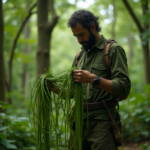Survival often hinges on your ability to understand and adapt to your environment. Advanced tracking skills are essential for finding resources, evading danger, and observing wildlife. Whether you’re navigating rugged terrains or gathering intel on your surroundings, honing these skills can make all the difference.
This guide will walk you through key techniques, from identifying tracks to reading subtle signs of animal or human activity.
Why Tracking Skills Are Crucial
Tracking is more than just identifying footprints. It’s about interpreting the story left behind by movements, behaviors, and environmental changes. For survivalists, these skills are invaluable for several reasons:
- Finding Food: Tracks can lead you to animals, edible plants, or water sources.
- Avoiding Danger: Spotting signs of predators or human activity can help you stay safe.
- Navigating the Environment: Understanding trails and terrain can prevent you from getting lost.
By sharpening these skills, you’ll enhance your ability to thrive in any survival situation.
Key Techniques for Advanced Tracking
1. Identifying Tracks
Footprints are the bread and butter of tracking. Look for shape, size, and depth to determine the type of animal or person and their movement direction. For example:
- Deer Tracks: Hoof prints shaped like an inverted heart, often found near water or vegetation.
- Bear Tracks: Large prints with distinct claw marks, typically near rivers or wooded areas.
- Human Tracks: Shoe patterns can reveal group size, load carried, or speed of travel.
2. Reading Trail Patterns
Patterns in tracks provide clues about behavior:
- Straight Lines: Indicates deliberate movement, such as a predator stalking prey.
- Zigzag Patterns: Suggests grazing animals looking for food.
- Clustered Tracks: Often signal resting or feeding spots.
3. Recognizing Subtle Signs
Tracks are just one piece of the puzzle. Pay attention to additional indicators, such as:
- Broken Twigs: Evidence of movement through dense brush.
- Flattened Grass: A sign of animals lying down or passing through.
- Scratches or Scat: Reveal diet and species.
How to Practice Tracking in the Wild
The best way to learn is by doing. Here are some practical tips for practicing tracking skills:
Start Small
Begin with areas where animal activity is frequent, like parks or trails. Observe tracks and their context to build your confidence.
Use Tracking Tools
- Notebook and Pencil: Record observations and sketch tracks.
- Camera: Capture images for later study.
- Measuring Tape: Document track sizes for comparison.
Follow Trails Safely
When tracking animals, maintain a safe distance. Use binoculars to observe from afar and avoid putting yourself in danger.
Advanced Tips for Expert Trackers
1. Study Animal Behavior
Knowing how animals behave during different times of the day or seasons can give you an edge. For example:
- Nocturnal Creatures: Look for fresh tracks in the early morning.
- Migratory Patterns: Observe seasonal trails to predict movements.
2. Read Environmental Clues
Natural elements, like weather, can affect tracks. Rain may obscure prints, while dry soil makes them more visible. Learn to adjust your tracking approach based on these conditions.
3. Practice Aging Tracks
Distinguishing between fresh and old tracks is a key survival skill. Fresh tracks often have sharp edges and moist soil, while older ones are weathered or partially eroded.
Tracking Humans in Survival Situations
In scenarios where tracking humans is necessary—whether to locate a group or avoid confrontation—pay attention to:
- Discarded Items: Litter, fabric, or tools can mark a trail.
- Campfire Remains: Ash or soot reveals recent activity.
- Noise: Rustling or distant voices can indicate proximity.
When tracking humans, remain stealthy to avoid detection.
Integrating Tracking Into Your Survival Plan
Advanced tracking skills are only part of the equation. Combine them with other survival strategies for maximum effectiveness:
- Navigation Skills: Use a compass or natural markers alongside tracking.
- Camouflage Techniques: Stay hidden while observing your surroundings.
- Resource Management: Plan your energy and resources around what tracking reveals.
Learning From the Experts
Take inspiration from indigenous cultures and professional trackers. Many of their techniques are rooted in centuries of practice and understanding of the land. Consider reading books, attending workshops, or joining wilderness training programs to deepen your knowledge.
Common Mistakes and How to Avoid Them
Even seasoned trackers can make errors. Here’s how to sidestep common pitfalls:
- Ignoring the Environment: Always consider weather and terrain impact.
- Overlooking Small Details: Small signs, like hair or feathers, can be just as telling as tracks.
- Rushing the Process: Take your time to thoroughly analyze each clue.
Becoming a Master Tracker
Mastering advanced tracking skills requires patience, practice, and a keen eye. By learning to read the language of the wild, you’ll not only increase your chances of survival but also deepen your connection with nature.
Next time you’re outdoors, take the opportunity to practice these skills. Every track, trail, and subtle sign is a step closer to becoming a true expert in survival tracking.


